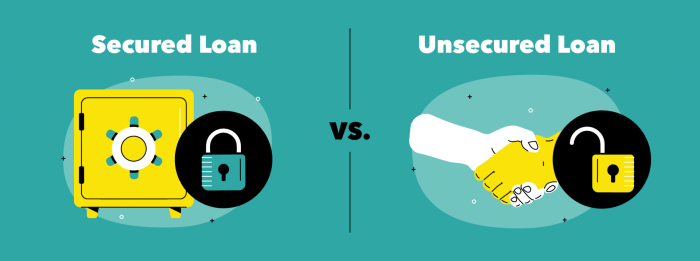Delving into the realm of Secured vs. unsecured loans, this introductory exploration aims to shed light on the nuances of each type of loan, providing a foundation for a deeper understanding of the topic.
Exploring the differences between secured and unsecured loans is crucial for individuals seeking financial assistance, as it can significantly impact their borrowing decisions and financial stability.
Secured Loans
Secured loans are loans that are backed by collateral, typically an asset that the borrower owns. These loans differ from unsecured loans in that they require the borrower to pledge an asset as security for the loan. In the event that the borrower defaults on the loan, the lender has the right to seize the collateral to recoup their losses.
Assets commonly used as collateral for secured loans
- Real estate properties such as homes or land
- Automobiles
- Investment accounts
- Jewelry or valuable collectibles
Advantages and disadvantages of secured loans
- Advantages:
- Lower interest rates compared to unsecured loans
- Easier approval process due to reduced risk for lenders
- Possibility of borrowing larger amounts of money
- Disadvantages:
- Risk of losing the collateral if unable to repay the loan
- Longer application process due to appraisal and verification of collateral
- May require good credit history or a high-value asset as collateral
Unsecured Loans
An unsecured loan is a type of loan that is not backed by collateral. This means that the lender does not have a claim on any of the borrower’s assets in case of default. Unsecured loans are typically granted based on the borrower’s creditworthiness and ability to repay the loan.
Types of Unsecured Loans
- Personal Loans: These are general purpose loans that can be used for various personal expenses such as home improvements, debt consolidation, or major purchases.
- Credit Cards: Credit cards provide a revolving line of credit that can be used for purchases and payments. The borrower is required to make minimum monthly payments on the outstanding balance.
- Student Loans: These loans are intended to help students cover the costs of tuition, books, and living expenses while pursuing higher education. They are typically unsecured.
Eligibility Criteria for Unsecured Loans vs. Secured Loans
When it comes to obtaining unsecured loans, lenders rely heavily on the borrower’s credit score and income to determine eligibility. Since there is no collateral involved, a strong credit history is essential to qualify for an unsecured loan. On the other hand, secured loans require collateral, which reduces the risk for the lender. As a result, secured loans may have less stringent credit requirements compared to unsecured loans.
Interest Rates and Terms

When it comes to borrowing money through loans, understanding the interest rates and terms associated with secured and unsecured loans is crucial for making informed financial decisions.
Interest Rates
Interest rates for secured loans are typically lower compared to unsecured loans. This is because secured loans are backed by collateral, reducing the risk for the lender. On the other hand, unsecured loans do not require collateral, making them riskier for lenders and resulting in higher interest rates for borrowers.
Repayment Terms
Repayment terms for secured loans are usually longer compared to unsecured loans. This is because the presence of collateral provides a sense of security to the lender, allowing for more flexibility in terms of repayment. In contrast, unsecured loans often come with shorter repayment terms due to the higher risk involved for the lender.
Impact on Overall Cost of Borrowing
The combination of interest rates and repayment terms directly impacts the overall cost of borrowing. Secured loans with lower interest rates and longer repayment terms may result in lower monthly payments and a lower total cost over time. On the other hand, unsecured loans with higher interest rates and shorter repayment terms can lead to higher monthly payments and a higher total cost of borrowing.
Overall, understanding how interest rates and terms differ between secured and unsecured loans is essential for choosing the most suitable option based on individual financial needs and circumstances.
Risks and Considerations
When considering taking out a loan, whether secured or unsecured, it is crucial to understand the risks involved and how to mitigate them effectively.
Risks Associated with Secured Loans
Secured loans pose higher risks compared to unsecured loans due to the collateral involved. If the borrower defaults on a secured loan, the lender has the right to seize the collateral to recoup their losses. This can result in the loss of valuable assets such as a home or a car.
- Defaulting on a secured loan can lead to foreclosure or repossession of the collateral.
- The borrower may incur additional fees and penalties for late payments or default.
- If the value of the collateral depreciates, the borrower may still owe the remaining balance after the collateral is seized.
Consequences of Defaulting on Secured vs. Unsecured Loans
Defaulting on a secured loan can have more severe consequences compared to an unsecured loan. With a secured loan, the lender has a legal right to the collateral, which can lead to asset loss. In contrast, defaulting on an unsecured loan may result in damage to the borrower’s credit score and potential legal action, but there is no collateral at risk.
Tips to Mitigate Risks
- Ensure you can afford the loan payments before taking out a loan.
- Read and understand the terms and conditions of the loan agreement, including the consequences of default.
- Consider building an emergency fund to cover loan payments in case of financial difficulties.
- Regularly review your financial situation to stay on top of payments and avoid default.
